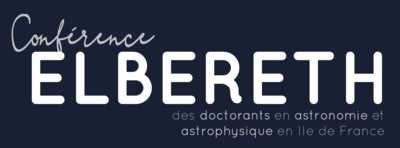Orateur
Description
Part of the ionizing continuum (Lyman continuum, LyC) produced by young stars can leak out of its host galaxy and ionize its surroundings. At high redshift, constraining the contribution of such LyC-leaking galaxies to the total ionizing budget is crucial as several studies consider primordial, low mass galaxies as the best candidates to explain the origin of reionization. Indeed, simulations (e.g. Robertson et al. 2013, Rosdahl et al. 2018) show that leaking galaxies with average escape fraction between 10 and 20% could fully account for the reionization without invoking any contribution from other sources (e.g. luminous active galactic nuclei, AGN). However, direct measurements of the escape fractions are extremely difficult as the leaking photons are easily absorbed by the intergalactic medium (IGM); they are only possible in a very narrow redshift range and suffer from large measurement uncertainties (e.g. measured along a single line of sight).
Instead, indirect tracers such as the Lyman alpha line (Verhamme et al. 2015, Kakiichi et al. 2019) or absorption lines (Gazagnes et al. 2018, Chisholm et al. 2020) have been used to probe the structure of the ISM but such methods are also sensitive to line of sight variations and absorption effects from the IGM. Using emission lines in the optical and infrared range allows to get rid of viewing angle dependencies but a complex modelling step is needed to disentangle the emission arising from different phases (ionized gas, photo-dissociated region, molecular phase and diffuse ionized gas) merged in a single beam. This method is promising as current ground-based facilities (e.g. ALMA) and up-coming missions (e.g. JWST) will grant access to spectroscopic tracers up to redshift above 7. Meanwhile, local, metal-poor, galaxies are ideal environments to study the mechanisms at play in primitive conditions.
I will hence present a grid of Cloudy (Ferland et al. 2017) models to investigate low-metallicity galaxies using a combination of different sectors, some of them being density-bounded and including the potential contribution of X-ray sources. To successfully constrain the parameters of this predictive representative galaxy model, I co-developped MULTIGRIS (Lebouteiller et al. in prep) a new Bayesian code using Monte Carlo sampling, including additional constraints through priors and upper limits. Among the various applications, MULTIGRIS can produce probability density functions of any physical parameters directly or indirectly available in Cloudy (ionizing photon escape fraction, dust mass, H2 mass etc...).
I will present here a first application on the local, low metallicity Dwarf Galaxy Survey (Madden et al. 2013), examining the complex dependencies of the escape fractions with various parameters and especially how metallicity impacts the inferred escape fraction.
| Field | InterStellar Medium |
|---|

